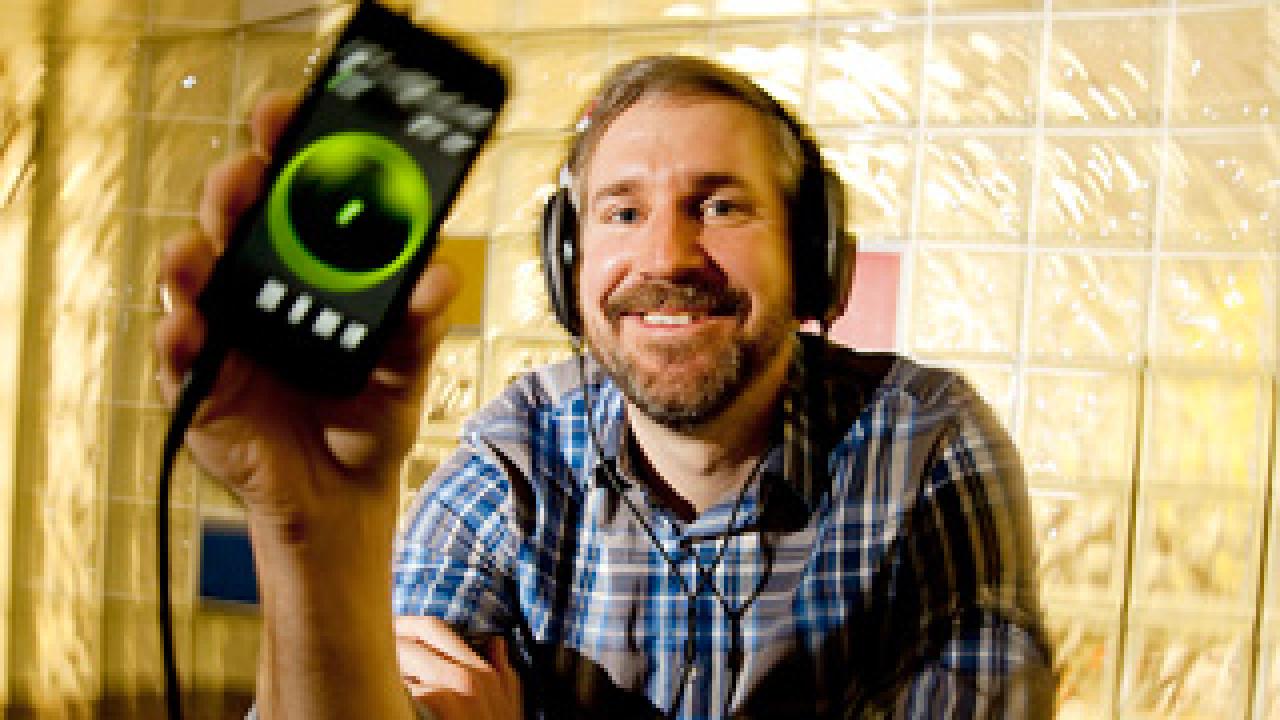Fifteen years of research at the University of California, Davis, is being turned into commercial products by Dysonics, a startup company based in San Francisco. Since becoming the first "graduate" from the Engineering Translational Technology Center, a technology incubator at the UC Davis College of Engineering, Dysonics has launched an iPhone app and is developing a broad product range for future launch. The company currently has 10 employees.
Dysonics aims to reproduce a natural sound experience with sound delivered through headphones. The Rondo iPhone app can change the apparent size of the room, and adds directionality. Add the RondoMotion sensor clipped to your headphones, and sounds will appear to change location as you move your head.
The Rondo app and RondoMotion work with existing audio files. The company is also working on generating its own content by recording live events on specialized media. The technology has promise not just for listening to recorded music in a new and richer way, but for a more realistic, "virtual reality" audio experience for teleconferencing and video games.
"There are multiple applications with market potential," said David McGee, executive director of InnovationAccess, the unit within the UC Davis Office of Research responsible for intellectual property management and licensing. "Dysonics is a great example of a faculty-led startup with cool technology and very active support from the college and university."
UC Davis played a crucial role in getting Dysonics started, said co-founder and President Ralph Algazi, professor emeritus of electrical and computer engineering at UC Davis. The company is based on research conducted at UC Davis by Algazi and co-founders Richard Duda, a research scientist at UC Davis, Robert Dalton Jr., a former undergraduate and graduate student in Algazi's lab, and colleagues at the university over several years.
Algazi is interested in how sound waves arriving at our ears carry information, for example, about the size and shape of the room or the direction of the sound source. For example, a piece of music sounds different played in a concert hall or on home theater system than it does played in a small room, or over ear buds. If we turn our heads toward a sound source, our experience changes.
Starting about 10 years ago, the team developed software and equipment that allows motion tracking with headphones, so that when you move your head the sound source appears to stay in the same place.
Algazi was one of the first inventors that McGee met with when he arrived on campus in 2004.
"Ralph gave me a demonstration of the technology, and I was just blown away," McGee said. "This was an entirely different and richer audio experience from what I was used to."
InnovationAccess worked with Algazi and licensed the technology to an existing company. But changing business priorities took that company in a different direction, and UC Davis took the license back so as to ensure that this promising technology would not languish.
By the end of the decade several trends were converging that would lead to the formation of Dysonics.
Motion-sensing technology has become much cheaper and more mobile. At the same time, the boom in mobile devices means people want to be able to listen to music wherever they are, setting off explosive growth in the market for headphones.
"When Ralph told me that he had decided to move the technology forward himself, I was very pleased and we worked very closely with him to make it happen," McGee said. "Empowering an entrepreneurial campus researcher to turn their research into societal impact is what technology transfer is all about."
Algazi talked to Bruce White, then dean of engineering, and ETTC director Jim Olson, a former undergraduate student of Algazi's. The company was founded in March 2011, and just over a year later had secured sufficient funding from angel investors to leave the incubator and strike out on its own.
"ETTC was invaluable for us in securing funding and legal work," Dalton said. "We had a heavy engineering focus and we needed business knowledge."
One unique feature of the ETTC incubator is that philanthropic donations to the College of Engineering enable it to reduce initial patent costs for startup companies. Filing patents costs the university money. Usually, when a company licenses a patent from UC Davis, it agrees to reimburse these out-of-pocket costs as well as support future ongoing costs of maintaining the licensed patents.
"ETTC is able to directly reimburse the university for up to $15,000 in patent costs. The ETTC startup is not charged for those costs. This is enormously beneficial to startups at a stage when they have very little cash," McGee said.
It also permits the startup to secure its foundational intellectual property, a very important consideration for investors. UC Davis Chancellor Linda P.B. Katehi recently approved the use of income from licensing intellectual property to maintain ETTC's ability to cover these costs.
The young company also worked with InnovationAccess to license the patents held by UC Davis.
The company recently (April 24) launched a "kickstarter" campaign to raise funds for its next product, a wireless motion sensor for audio headphones that works with the company's Rondo iPhone app. The company aims to raise $60,000 from the fundraising drive to complete the product.
More than 45 startup companies have been spun off from UC Davis since 2005. The campus currently holds a portfolio of 838 foreign and U.S. patents, and earned income of $13.6 million in fiscal year 2011-12.
Media Resources
Andy Fell, Research news (emphasis: biological and physical sciences, and engineering), 530-752-4533, ahfell@ucdavis.edu
Ralph Algazi, Electrical and Computer Engineering, (530) 752-8066, vralgazi@ucdavis.edu
